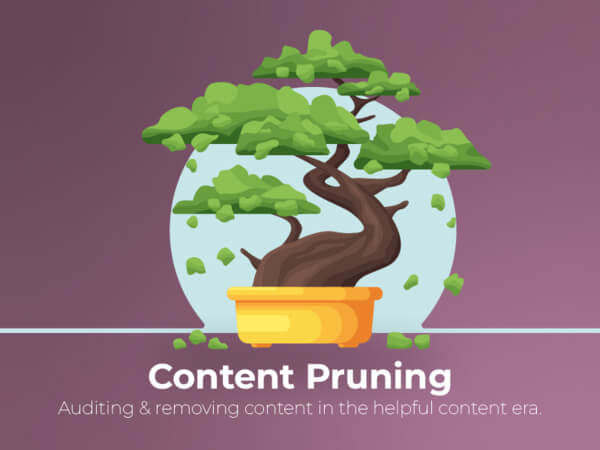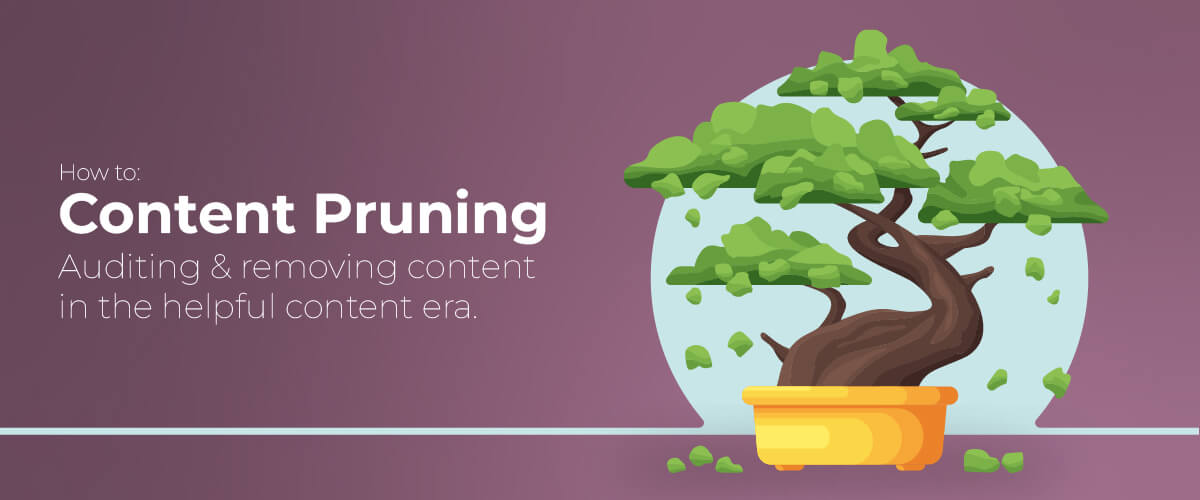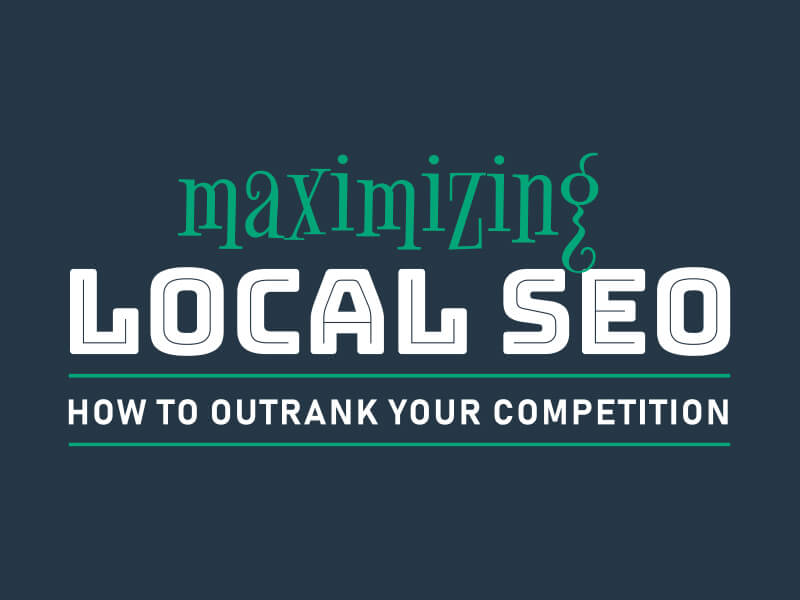Ahh yes, the ancient art of content pruning is seeing a renaissance in the wake of Google’s Helpful Content update.
Except pruning content isn’t that old of an SEO technique and is one that has been feared (rightly so) by many SEOs. As the power of a successful prune can breathe life back into a website, an ugly hack job can seriously harm your website’s performance.
So, be mindful of who you’re handing those pruning shears to. 💇♀️
In this blog post, we’ll look at what content pruning is exactly, how it impacts your SEO and the best way to go about conducting a successful content pruning strategy.
Jump to: How to prune your content.
What is Content Pruning?
Content pruning is the practice of identifying underperforming or non-helpful web pages and removing them from your website to improve your site’s overall SEO health.
This can be done through a number of methods, such as deleting outdated blog posts, removing low-quality pages, merging similar content, or redirecting URLs to more relevant content.
The full pruning process involves auditing and analysis to determine your content’s fate—whether it be reviving, repurposing, or ultimately the removal of low-quality content.
The goal of content pruning is to improve your website’s overall health by removing the dead weight—thus improving user experience and focusing your site’s energy on authoritative content that is helpful for people (and Google).
Why Prune Content?
Content pruning is one of the most underutilized SEO techniques that can deliver results for your website.
The idea behind a good pruning session comes from the technique of caring for bonsai trees, so we’ll approach this Mr. Miyagi style (80s movie reference). By cutting the low-quality, often low-traffic content from your website, you provide more opportunities for your star content to shine.
Now, this isn’t just slashing old pages for the sake of cutting content from your site.
This is a calculated method to improve your website’s overall quality, which can lead to better rankings and more traffic from search engines.
By removing poor performing pages, you can improve the ratio of high-quality indexed pages that exist on your site. The higher the ratio of quality pages compared to the total number of pages on your site can lead to an enhanced performance in the SERPs, as the overall ‘value’ of your site has improved.
Benefits of Content Pruning
With Google’s latest helpful content and core algorithm update launching within the last month or so, now is a perfect time to clear out some lackluster content from your site. This is especially true if it has been a while or you have never audited your content in this fashion.
With a further emphasis on creating better experiences and more helpful content, its become more of a necessity to reevaluate the pages on your website and see if it is helping or hurting your overall site health.
Some of the major benefits of content pruning include:
Higher Quality Content
Elevate your overall quality of content.
When you remove outdated or poor-quality content from your website, you improve your site’s overall quality. This impact is two-fold: (1) you’re able to remove old content that is often unhelpful or outdated for visitors and (2) search engines, like Google, consider the overall quality (and authority) of a website when determining its rank within the search results.
Improve UX
Helping people find the right stuff.
If there’s a lot of low-quality or outdated content on your site, it can be hard for people to find the accurate information they’re looking for.
No one likes to read an article, only to find out the post is from 7 years ago and no longer reflects the modern advice they should be receiving.
This poor user experience can speak to your credibility as a business and website—leaving people feeling frustrated and like you wasted their time. Rough.
Maximize Crawl Budget
Getting the most from Googlebot.
Search engines may not index all the pages on your site if they think they’re low quality. When you prune pages from your site, you’re maximizing your crawl budget by helping Googlebot more easily find your best content—helping you get the most out of each crawl.
Helpful Content Era
For the people…and Google.
As the helpful content update continues to expand its scope, diligence with high-quality content will remain a priority. Continuing to monitor your site’s performance while removing or updating underperforming content periodically can help your site stay current with this next wave of algorithm advances.
Optimized Linking
Pointing to the right places.
A strong link strategy, for both internal and external links, can help your website on a number of levels.
Not only are you directing users to the most helpful content on (or off) your site, but you are also ensuring that you’re passing link authority to the right places on your site—helping elevate your over performance.
How to Prune Your Content
Let’s get into it! How to approach a strategic content pruning session. There are five-main-steps when thinking about a content pruning process for your website:
- Collect Your Content: Get a list of pages on your site.
- Gather Your Data: Grab performance data from available sources.
- Conduct a Content Audit: Evaluate how your content is performing.
- Finalize Your URL’s Fate: You’ve got options.
- Backup, Rollout & Monitor: Execute your plan and track its impact.
Step 1: Collect Your Content
Creating a list of all the pages on your website.
For this step, you can export a list of URLs from your CMS. If you’re unable to export from your CMS, you can grab a list of URLs from Google Analytics or Search Console.
The Analytics option won’t necessarily yield a complete list of URLs, as someone needs to visit a page for Google Analytics to record a visit. However, this can still be a great starting point, you may just be missing some pages that don’t see any traffic.
After you have collected a list of URLs, make sure to remove any duplicates, as this will serve as your master list in the content audit portion of this process.
Step 2: Gather Your Data
Grab page specific performance data from available sources.
You want to look at all the available data you have to help gain as many insights as you can on the URLs in question. The source data you accumulate here will help keep you from making any costly errors, such as mistakenly eliminating the wrong pages.
You can pull in a host of data from various sources including (but not limited to):
Google Analytics:
- All traffic — a breakdown of visits, unique pageviews, bounce rate, exit rate, conversions, page value on a page-by-page basis. In Google Analytics, Behavior > Site Content > All Pages> Export.
- Organic traffic — You can filter the All Traffic report to show only organic traffic by applying an Organic Traffic segment.
You’ll want to pull in data from the last 12 months along with data going back a few years. This can be helpful when determining the fate of your content—by understanding if the page has ever performed well, and not just how it has done in the past year.
Google Search Console:
- External Links — These are links pointing to your domain from another website. You want to consider the number and quality of links pointing to your site. It’s very important to not get rid of any URLs that are receiving quality links from other sources. In Search Console, navigate to Links > External Links > More > Export.
- Internal Links — These are links within your website that are linking to other pages on your own website. In Search Console, Links > Internal Links > More > Export.
- Search Results — This report allows you to export impressions, clicks, click-through-rate (CTR) and average position in the Google search results for each of your URLs. Within Search Console > Search Results > Pages > Export.
Bing Webmaster Tools:
- Backlinks — An alternative method of downloading your site’s backlinks provided by Microsoft. This data can help you understand how many other domains are pointing to your website.
- In Webmaster tools, Backlinks > Backlinks for Your Site > Pages > Download All.
- To get a numerical value of links pointing to each URL, you can quickly run the Excel function =UNIQUE(C:C) this will get you a list of all unique URLs listed in the target URL column.
- Then you can run another Excel function =COUNTIF(C:C, x2). The ‘x’ represents the column where you have your list of unique URLs. So, if you put your list of unique URLs in column ‘D’, the function would be =COUNTIF (C:C, D2). This will get you the number of backlinks pointing to each unique URL.
- Search Performance — This report provides insights into the number of impressions, clicks and average position in the Bing search results each page on your site has achieved.
In Webmaster Tools > Search Performance > By Page > Download All.
Content Management System:
In WordPress, there are several plugins that can help you export this data.
- Publish date — This displays when the post was originally published.
- Last updated — This shows you when the post was last updated.
- Word Count — An export of words per page can help identify thin content. You can also grab this info from site crawling software like Screaming Frog.
Google Search Operators:
- Indexed content — Using the search operator site:example.com. You can gather a list of URLs that google has indexed for your site.
- Dated references & content — using this advanced search operator, site:example.com intext:”2016″ | intext:”2015″ | intext:”2014″ | intext:”2013”. You can search for content on your website that has any of those years listed in the body of the page copy.
Quick note: there are several Chrome extensions that can help you quickly extract a list of the URLs listed on the SERPs when you conduct these searches.
Paid Tools:
There are many tools out there that can provide additional insights into your website’s performance on a page-by-page basis. If you have access to any of these advanced tools, please include this data to help you evaluate the performance of each page on your site.
Step 3: Conduct a Content Audit
Use data and evaluate how your content is performing.
It’s time to compile all that data into a content auditing document. You can use your data tool of choice such as Excel, Google Sheets, R, Power BI, etc.
We’re looking to match each URL up with the corresponding data points from each of our exports.
From there it’s a matter of weighing and evaluating each of these metrics on a page-by-page basis, compared to the overall performance of your website as a whole.
Your content auditing document should help you identify opportunities on what to do with each page of your site.
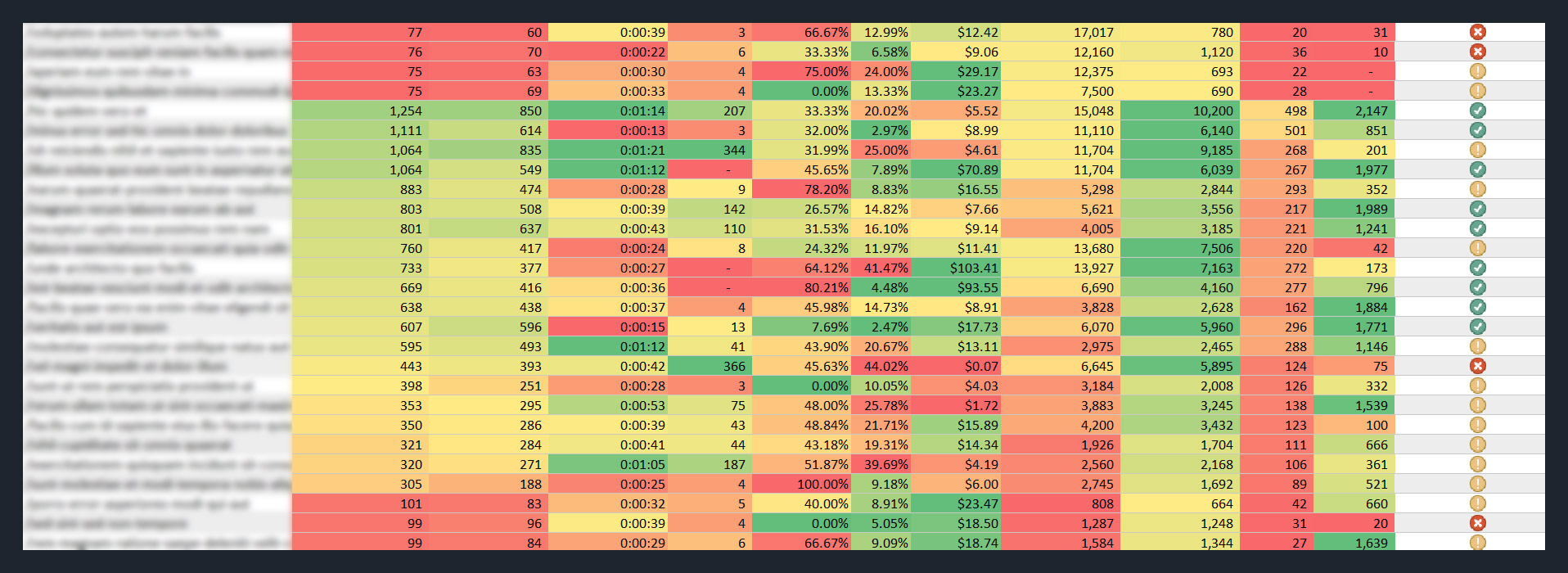
Using the exported data, the Excel document above correlates each of the data points to the corresponding URL and compares it to the overall performance of the website.
The spreadsheet should help identify any pages that are:
- Not getting any traffic
- Receiving minimal organic traffic
- Not leading to conversions
- Not assisting on the path to conversion (page value)
- Not getting many backlinks
- Featuring (potentially) outdated information
- URLs with a low word count (thin content)
The final column gives a suggested outcome for each page. Please keep in mind each URL should also be subject to a manual review (Step 4). Data can help us, but it can’t paint the full picture here.
Step 4: Finalize Your URL’s Fate
What are you going to do with all that content? You’ve got options.
Ok, so you have your content audit document and you’re now ready to determine the fate of your URLs. If you added a suggested outcome column, you’ll have an idea of where the data is leading and you can begin sorting your content into three groups:
- Keep it: do (basically) nothing. That was easy 😅
- Update it: Improve, update, combine or repurpose
- Remove it: 301, noindex or canonical
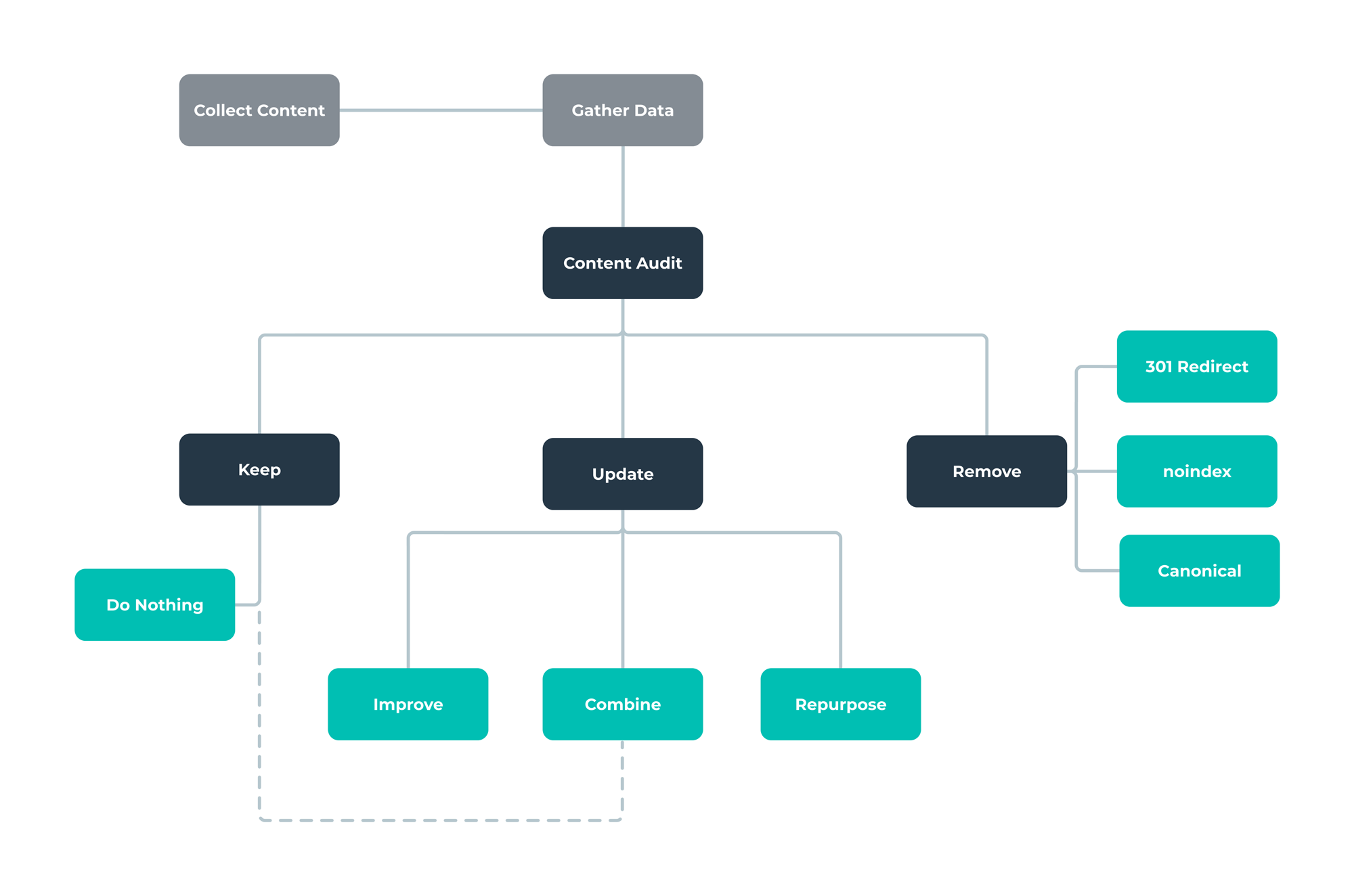
Now, each URL is still subject to manual review—just because your content audit suggests an outcome, does not mean it’s final. So here are a few more columns I add to my spreadsheet during a manual review before making any final decisions:
- Target keyword: The focus keyword/ phrase for the page. (Some paid tools can help automate this for you!)
- Ease of updating: Rate how easy the content would be to update (Scale 1-10).
- Notes: Any additional notes or thoughts.
- Final outcome: Note the final decision for each URL.
Whether you address these last few items or decide to skip them, you’ll at least want to make sure you add the ‘Final outcome’ column to your spreadsheet to mark the action you plan to take with each of these URLs after your manual review.
The “Keep It” Group
Do (basically) nothing.
This is the easy group. These are pages that are doing well—they drive traffic, have backlinks, convert users and generally rank well organically.
Additionally, this group will include any pages that should not be removed, like your privacy policy, contact page, terms and conditions and recently published pages that have not had time to properly evaluate.
You’re going to want to note the target keywords for each of these pages and look for any cannibalization that may occur from pages that don’t perform as well. We’ll identify those URLs in the next group and deal with them accordingly.
💡 Keyword cannibalization occurs when two or more URLs are competing for the same (or similar) target keyword.
The “Update It” Group
Improve, update, combine, or repurpose these pages with other content.
You’ve got options in this group. And if it’s been a while since your last pruning, this group could fill your content calendar for months.
These are the underachievers. This group consists of pages that generally bring in mediocre traffic, they may get a few backlinks, minimal conversions and currently rank outside of page one in SERPs.
These pages may have received a lot of traffic in the past, but currently are underperforming—take special note of these, as they can sometimes lead to quick performance boosts with the proper updates.
If you have a lot of pages, you’ll also want to rate the ease of updating each URL. As we know, some pages are more difficult than others and may involve significant updates to bring back to life.
The “Remove It” Group
301, noindex or canonical these pages.
These are the nonperformers. These pages never really received any traffic, don’t have any backlinks, they do not help with conversions and do not rank for their intended keywords.
You’ll need to make some decisions on what to do with these pages. You can:
- 301 Redirect these URLs to similar or updated pages on your site.
- Noindex pages that are beneficial to your users, but not to search engines.
- Canonical URLs to the preferred version of the page, when duplicate content exists covering the same (or similar) topic.
Step 5: Backup, Rollout & Monitor
Execute your plan and track its impact.
After the fate of your content has been decided, it’s time to take action!
Before doing anything, I’d recommend you create a backup of your website and all of your content. If by chance you need to undo the changes you’ve made, it’s nice to have a backup to reference or restore.
For the content you plan to repurpose, you’ll want to prioritize your content marketing efforts by sorting these URLs by ease of updating the material and the potential impact the new content could have on your website’s performance.
For pages you plan to remove, you may want to consider a slower rollout of changes if your website is on the larger side. As an example, you could remove a portion of the pages, then monitor your performance before continuing to eliminate additional pages.
As with any major changes to your website, you’ll want to continue to monitor the impact the changes are having on your site and adjust accordingly.
How Often Should You Prune Content?
The answer depends on the quality of your website’s content and how frequently it is updated. For most websites, it’s a good idea to add regular content pruning into your SEO and content strategy at least once a year. As for sites with content that is regularly updated, a bi-annually or even a quarterly content pruning schedule may be the most helpful.
Wrapping Up
With recent Google algorithm updates and an ever-increasing need to demonstrate and deliver E-A-T content, maintaining the quality of your website’s content has never been more important.
By removing the pages that are holding your website back, you not only can adhere with Google’s latest quality recommendations, but also provide your users with the best experience on your website—hopefully leading to more visibility and conversions.

